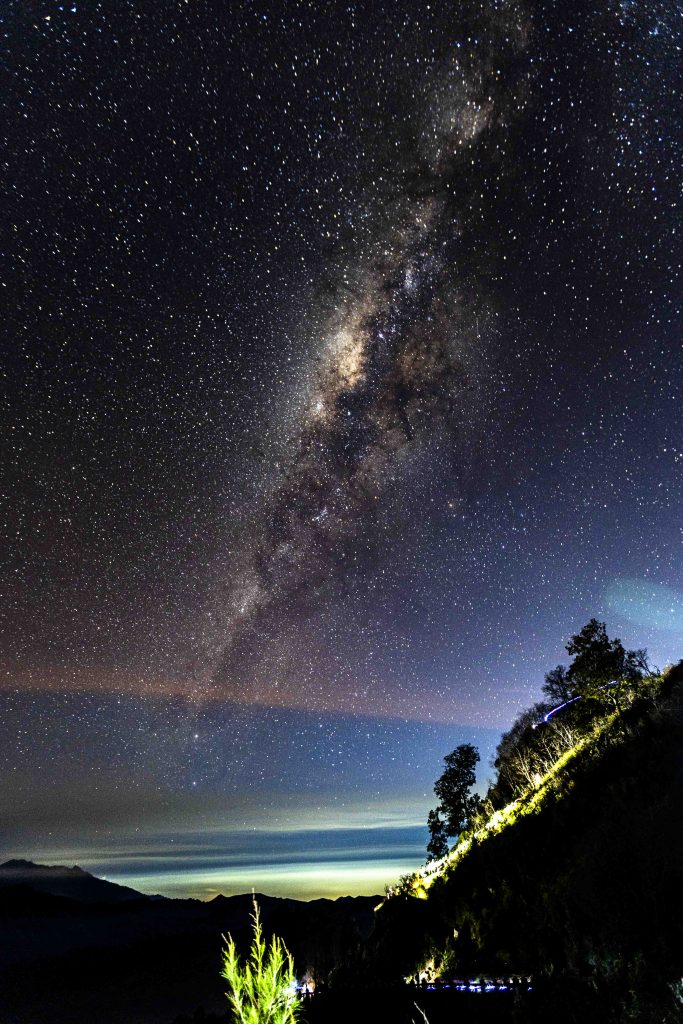Milky Way of Bromo
A Snapshot of the Milky Way from Bromo. The knowledge that a star is a sun to each their own solar system is a reminder that our universe is nothing but immense.
What we’ve learned about the cosmos is minuscule to what truly lies out there and might forever remain a mystery to humankind. We often forget that compared to the vast, infinite universe, we are but specks of particles living in a tiny floating rock that seems smaller than a grain of sand or a speck of dust. To remind us that far above our skies is a completely different world than what we know, we are treated by the universe, a glimpse of that mysterious beauty it holds. In several places in the world, humankind is treated by the Milky Way’s sight at the right time and place, a galaxy of which our very own solar system is a part. Twinkling above us like a sea of diamonds in the darkness of the night, a hazy band of light visible by the naked eye.

Those lucky enough to see it in its glory themselves speak of nothing but its wonder and bewitchery. People often speak of the sunsets and sunrises that fall and rise beyond Mount Bromo, but one of its most unique appeals is hardly ever discussed. When the sun bids farewell at dusk to make way for the other stars to come and display their magnificence, those present at the show presented to us by mother nature will see the small sliver of what the cosmos has in store for us. If you’re there at the right place and the right time, your diligence will be rewarded with sight; not many will be able to behold. The sky will conduct for you the stars to form the Milky Way on its dark stage. To see this rare sight, luck was once believed to be held by the visitors, but now the years have passed. That luck has turned into knowledge to prevent anyone from missing this orchestrational composition of mythical proportions. The Milky Way will reveal itself to those visiting Bromo on most nights, starting from the end of February until well into October. Although the length of its visits seems to be quite long, each night’s crescendo differs in its months.

During its prima nota, the Milky Way will reach its climax at 03.00 and will steadily decrease its wait time as the months go by. In April, you will see it at its full glory right as the clock strikes midnight. To see its glory in May, those visiting need only to wait until 23.00. To have a light supper accompanied by its splendour, June and July are the perfect months to do so as the show reaches its peak at 21.00. Dinner under the cosmos is best taken during August until October, whereas early as 19.00 can visitors marvel in its radiance. Those gifted with the ability to paint beauty through light may share what they see through photographs and printed film. To capture the sight of the Milky Way, one must be clever enough to outsmart the cycle of the moon. The small rock accompanying the Earth is the little-known timekeeper for when the photographs will show the stars at their best. From March until May, the new moon will signal the start that ends at the crescent in seven days. June and beyond finds itself agreeing the most with the cycle after the moon, showcasing its full splendour.

The proper equipment is, of course, needed to capture it all. Those looking to spread what they have seen to others should bring a camera with the highest ISO, the lowest aperture, and 30 seconds for its shutter speed. Capturing that magnificence in its entirety is no easy task, but using wide lenses and a tripod will greatly aid the photographer’s mission. Finally, those artistic souls wanting to leave their own unique marks may bring a flashlight for light painting as a way to leave their own signature on the picture. Darkness is best to put all focus on the stars, with the best spots in Bromo being the Sand Sea (Lautan Pasir) and near the Boten Pura, where the sky’s mythical painting meets the mystic surroundings the land offers
